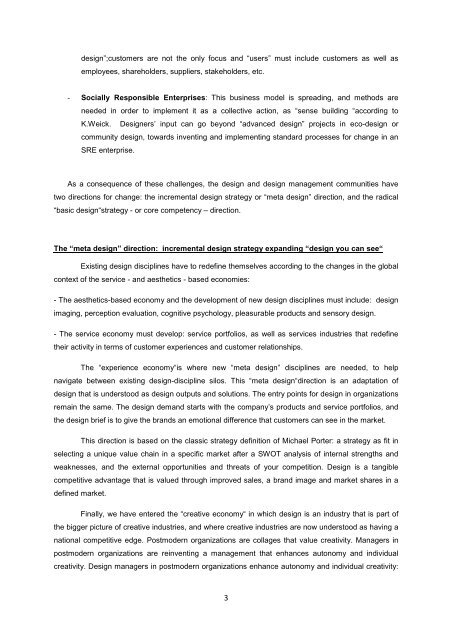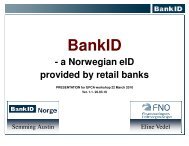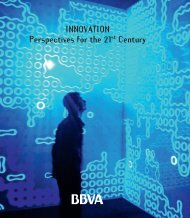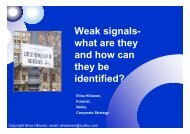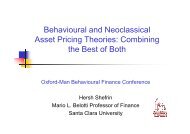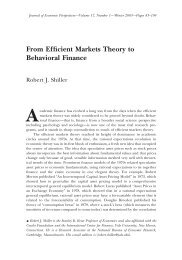Design Management as core competency
Design Management as core competency
Design Management as core competency
You also want an ePaper? Increase the reach of your titles
YUMPU automatically turns print PDFs into web optimized ePapers that Google loves.
design”;customers are not the only focus and “users” must include customers <strong>as</strong> well <strong>as</strong><br />
employees, shareholders, suppliers, stakeholders, etc.<br />
- Socially Responsible Enterprises: This business model is spreading, and methods are<br />
needed in order to implement it <strong>as</strong> a collective action, <strong>as</strong> “sense building “according to<br />
K.Weick. <strong>Design</strong>ers’ input can go beyond “advanced design” projects in eco-design or<br />
community design, towards inventing and implementing standard processes for change in an<br />
SRE enterprise.<br />
As a consequence of these challenges, the design and design management communities have<br />
two directions for change: the incremental design strategy or “meta design” direction, and the radical<br />
“b<strong>as</strong>ic design“strategy - or <strong>core</strong> <strong>competency</strong> – direction.<br />
The “meta design” direction: incremental design strategy expanding “design you can see“<br />
Existing design disciplines have to redefine themselves according to the changes in the global<br />
context of the service - and aesthetics - b<strong>as</strong>ed economies:<br />
- The aesthetics-b<strong>as</strong>ed economy and the development of new design disciplines must include: design<br />
imaging, perception evaluation, cognitive psychology, ple<strong>as</strong>urable products and sensory design.<br />
- The service economy must develop: service portfolios, <strong>as</strong> well <strong>as</strong> services industries that redefine<br />
their activity in terms of customer experiences and customer relationships.<br />
The “experience economy“is where new “meta design” disciplines are needed, to help<br />
navigate between existing design-discipline silos. This “meta design“direction is an adaptation of<br />
design that is understood <strong>as</strong> design outputs and solutions. The entry points for design in organizations<br />
remain the same. The design demand starts with the company’s products and service portfolios, and<br />
the design brief is to give the brands an emotional difference that customers can see in the market.<br />
This direction is b<strong>as</strong>ed on the cl<strong>as</strong>sic strategy definition of Michael Porter: a strategy <strong>as</strong> fit in<br />
selecting a unique value chain in a specific market after a SWOT analysis of internal strengths and<br />
weaknesses, and the external opportunities and threats of your competition. <strong>Design</strong> is a tangible<br />
competitive advantage that is valued through improved sales, a brand image and market shares in a<br />
defined market.<br />
Finally, we have entered the “creative economy“ in which design is an industry that is part of<br />
the bigger picture of creative industries, and where creative industries are now understood <strong>as</strong> having a<br />
national competitive edge. Postmodern organizations are collages that value creativity. Managers in<br />
postmodern organizations are reinventing a management that enhances autonomy and individual<br />
creativity. <strong>Design</strong> managers in postmodern organizations enhance autonomy and individual creativity:<br />
3


